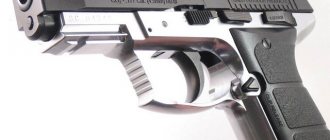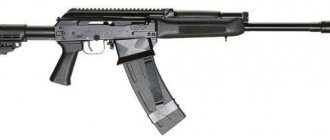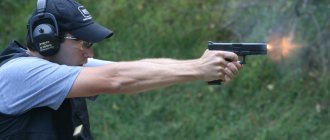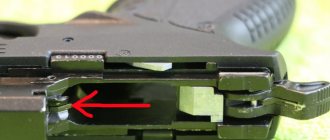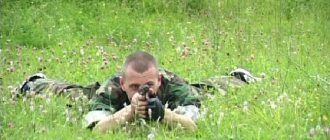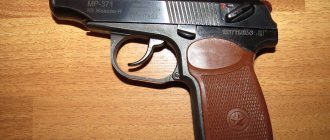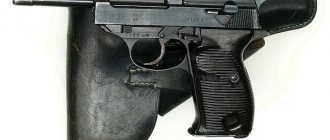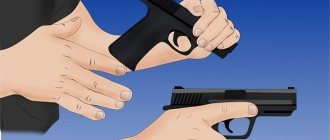Development history
The idea of developing the first Russian pistol intended for practical shooting appeared back in the late 90s. It was at this time that sports shooting began to actively develop in Russia. In those years, some models of IL, PM, and APS were used for these purposes. However, none of these pistols met the requirements set by the international community. Therefore, the weapon was used only in domestic competitions. Athletes had to travel to tournaments in other countries in order to fully participate in professional training.
With the advent of the Yarygin pistol, specifically its sports version, produced under the name “Viking,” sport shooting in the Russian Federation became a separate accredited sport. However, more powerful weapons were still required to compete with foreign pistols.
In this regard, the task arose to create a reliable, convenient and accurate pistol that fully meets the requirements for weapons for practical shooting.
The predecessor of the PE 10 pistol was the PE 9 model, released in 2007. After a series of tests, the weapon was modified, and the modified version was named PE 9M. The development of weapons was carried out at the ObshcheMashTsentr enterprise, whose management curtailed its activities after some time, and the assembly was never completed.
Further work on Efimov’s pistol was carried out already in . This company was created in 2016 by a company of professional shooters. A year later, in 2017, the PE 10 pistol saw the light of day, which in the spring of this year was tested and received a certificate of state certification.
Features of the PE 10 pistol
This is the only pistol in Russia made for the .40 caliber Smith & Wesson. The full production cycle is carried out in Russia, without the use of imported parts (with the exception of the store, which is ordered from abroad).
The PE 10 pistol is self-loading, automatic. Automation operates by using the recoil of a short-stroke barrel. This scheme has been used in the development of small arms since 1931 and has proven itself in the production of pistols using powerful cartridges.
To lock the PE 10 barrel, 3 lugs are used. Locking occurs at 1.3 mm with the barrel skewed. In the locked position, part of the barrel is raised in relation to the slides of the bolt mechanism; when rolled back, it is placed parallel, on the same level with them. During the movement of the bolt, the barrel does not move, due to this the dynamic performance is significantly improved. The stroke length before unlocking is 4.6 mm. This “long” unlocking mechanism allows combustion products after a shot to leave the internal cavities of the barrel as quickly as possible, thereby reducing the amount of carbon deposits on metal surfaces.
Shooters testing PE 10 note an almost complete absence of soot even after 100 or more shots. This extends the gun's uptime.
Modern Application
Today the PE 10 pistol is used in Russia for domestic and international practical shooting competitions. The weapon is common among professional shooters and sports shooting enthusiasts.
New pistol by Evgeniy Efimov
The appearance of a new pistol in modern Russia is always very noticeable, especially if the weapon was not developed in famous weapons design bureaus with a long history. It has long been the custom that the state has completely monopolized the process of weapons development, giving priority to the military sphere. Therefore, the demonstration of a new sports pistol designed by E. B. Efimov, held in March 2017, became a real event. What is this pistol and what are its prospects?
In Soviet times, competitive shooters had little reason to complain about their weapons. They had at their disposal both initial training pistols - for example, the famous "Margolin", with which more than one generation of shooters began their careers - and high-quality sports pistols. This was, for example, the XP-64 designed by E.L. Khaidurov, with which Soviet shooters reaped a “golden harvest” at the Olympics. The success of sports pistols HR-64, IZH-HR-30, IZH-HR-31, HR-79, TOZ-35, TOZ-36, TOZ-49 and others was greatly facilitated by the fact that Efim Khaidurov was not just a designer, but also a master of sports in bullet shooting, a multiple winner of various championships.
One of many: IZH-HR-30 sports pistol designed by E. L. Khaidurov and V. A. Razorenov https://forum.guns.ru
However, in the 21st century the situation has changed. If the security forces, as a result of the competition on the “Rook” theme, still received as many as three different pistols: PYA, GSh-18 and SPS, then there was no reason for optimism in sports. The worst situation turned out to be in a new form that has been gaining popularity in Russia since 1999 - practical shooting according to the rules of the International Practical Shooting Confederation (IPSC). Even in the “serial” class, the Viking, the civilian version of the Yarygin pistol, had difficulty competing with foreign models for a number of reasons. In the “standard” or “open” classes, where it was desirable to use .40S&W or similar cartridges to get additional points for the power factor, Russian shooters could choose weapons only among models from foreign manufacturers. Moreover, in recent years, after the introduction of sanctions, this process has become noticeably more complicated.
Created by international-class master of sports in practical shooting Evgeniy Efimov, the PE10 pistol is designed to fill exactly this niche. Unlike the “Viking” or other “fenced” models, Evgeny Borisovich initially designed his pistol as a weapon for sport, moreover, as a weapon of a specific “standard” class in practical shooting. The designer from St. Petersburg did not try to reinvent the wheel for the hundredth time, but used time-tested, well-developed schemes. In most cases, this approach is completely justified: the most successful solutions for short-barreled weapons were invented and developed more than 100 years ago, and a modern designer, as a rule, is required to ensure their most successful layout for the planned tasks.
So far, the new pistol exists in only two copies https://spec-naz.org
In this case, it was planned to create a high-quality domestic sports pistol capable of competing with foreign analogues. This weapon could shoot reliably for a long time and accurately in various conditions (competitions are not only held in indoor shooting ranges) when using cartridges of different quality. The study of the general layout of the pistol and its individual components, carried out on the basis of personal rich experience in operating sports weapons and Efimov’s design and teaching activities, should ensure both long and successful operation of the weapon and allow the shooter to fully realize his potential in terms of accuracy and speed of fire.
The only borrowed part in the pistol is the available and widespread magazines from the Czech CZ-75TS. At the request of the customer, it is possible to install new sighting devices from other manufacturers, if the athlete is somehow not satisfied with the factory ones. The rest of the PE10 parts are original.
The demonstration of the PE10 pistol took place on March 11, 2022 at the St. Petersburg sports and shooting club "Nevsky". In the photo, the author tells those present about his brainchild https://vk.com/prospbcom
Since today there are only two prototypes in operation, it is difficult to speculate for a long time about what the PE10 will be like in action. The pistol has passed state tests, which also means testing by firing high-pressure cartridges. The total firing of one of the samples currently amounts to more than 13,000 rounds, with only three delays noted (not counting misfires due to low-quality cartridges). The pistol was cleaned approximately after every 600 shots - no significant wear was observed on the parts, and the pistol continues to shoot actively.
All other conclusions can and should be drawn based on the results of using at least the first few dozen production pistols.
For now, it is worth noting that the birth of the PE10 was quite successful, and now the most important issues fall into the category of production rather than design ones. Will Evgeny Efimov and his partners be able to provide the first batch of 50 pistols with a similar level of quality? And what about the next one? Individual approach to shooters? Timely repairs and provision of spare parts?
There were enough people willing to try out the new weapon and shoot from it https://vk.com/prospbcom
It is no secret that the popularity in practical shooting of various variants of the Colts of the 2011 series or the CZ-75 and Tanfolio is not least due to the fact that for these models there is already a huge market for parts for repair and tuning. Leaving aside the question that shooters often pay more attention to the pistol than to improving their shooting skills, we can say that they can “customize” the models already on the market to suit themselves within a wide range, and in case of any problems it is easy to find a replacement failed part.
If the serial production of the PE10 manages to maintain high sporting and technical qualities, it may well be that soon the next gold medals will be won by domestic shooters, just like decades ago, with weapons developed and produced in their own country.
Efimov PE10 pistol in .40s&w caliber. Pistol review for practical shooting
Video review of the PE10 pistol. The review briefly touched upon the history of its creation, examined in detail the design and principle of operation, and also fired the weapon. The PE10 pistol in .40 S&W caliber was created by the Russian (also known under the STM Arms brand) in 2016-2017 and passed state tests and certification in March 2022. This model is specially designed for use in practical shooting competitions - IPSC Standard division (major power factor). The designer of the PE10 pistol is Evgeniy Efimov. The letter “E” in the designation of the pistol is taken from the developer’s last name, and the number “10” is the caliber in millimeters - 10x22 mm (.40 S&W). The design of the PE 10 is a self-loading pistol, the automatic operation of which is based on the use of recoil of a barrel coupled to the bolt with its short stroke. The barrel is locked on three lugs by 1.3 mm with the barrel skewed. In the locked position, the breech of the barrel is raised relative to the bolt slides and rotated by one degree, and when the bolt is unlocked and rolled back, the barrel axis is parallel to the bolt slides. That is, after unlocking, the barrel remains motionless throughout the entire movement of the bolt, which improves dynamics. The barrel is skewed by a shaped cutout made in the lower boss of the breech. The barrel stroke before unlocking is 4.6 mm. This “late” unlocking allows the bullet to leave the barrel without changing the aiming position, and as a result, almost all combustion products of gunpowder have time to leave the barrel, significantly reducing the appearance of soot on the internal surfaces of the pistol. The barrel has 6 right-hand rifling with a pitch of 406 mm. The diameter of the barrel at the front is 15.5 mm, and in the chamber area it is 17.6 mm. This geometry provides a large margin of safety, guaranteeing resistance to destruction with any cartridge. The thickness of the lower massive boss of the barrel, in which there is a figured cutout that provides locking and unlocking, is 9 mm. The diameter of the contactor axis is 6 mm. Moreover, during the reloading cycle, the contactor axis interacts with the figured cutout only when unlocking and locking. The barrel is stopped after a stroke of 4.6 mm by contacting the rear plane of the lower boss of the barrel with the corresponding support plane in the frame, completely unloading the lock, and the width of the metal behind the support plane in the frame is more than 10 mm. The specific geometry and relative position of the inclined holes in the front part of the bolt allows the barrel to move freely in the bolt after unlocking, while in the locked position there is no vibration of the barrel relative to the aiming position. The trigger mechanism is single type, self-cocking is not provided. The safety lever is double-sided, rotates upward by twenty degrees, while blocking the sear and trigger, breaking the contact of the sear nose with the cocking mechanism. The entire trigger is mounted in a block, which, during assembly, holds the safety levers in the frame and is fixed by the trigger axis. The trigger axis, when it is tension-fitted in the frame, can only be knocked out with the safety on fully engaged; when firing, the axis is additionally blocked by the safety wall. The disconnection of the trigger rod from the sear when the bolt is retracted is carried out by two disconnectors located on the sides in the rear grooves of the frame along which the bolt slides. The working stroke of the trigger at the end of the spoke is 2 mm with a tension of 1 kg, and the dip after the trigger is pulled is no more than 0.3 mm. The lower part of the pistol consists of two parts: the frame itself and the handle. A magazine extender is attached to the bottom of the handle on the grooves, securely fixed by the conical part of the heel of the mainspring. The frame and the handle are connected using three screws, which do not shear during recoil, because the handle has a supporting surface, which absorbs the entire impact. The magazine latch, consisting of the latch itself and the spring, can be installed at the shooter's discretion on either the left or the right. The weapon is fed with ammunition from a magazine from a CZ TS pistol with a capacity of 17 rounds. The pads are made of aluminum and have anti-slip inserts. The PE10 pistol consists of 60 parts. Characteristics: • Caliber – .40 S&W (10x22 mm) • Weight (without cartridges) – 1280 mm • Dimensions – 224x147x44 mm • Barrel length – 125.5 mm • Bolt stroke – 50 mm • Bolt thickness – 25 mm • Trigger force – 0 .8–1 kg • Sighting line length – 178.5 mm • Magazine capacity – 17 rounds
